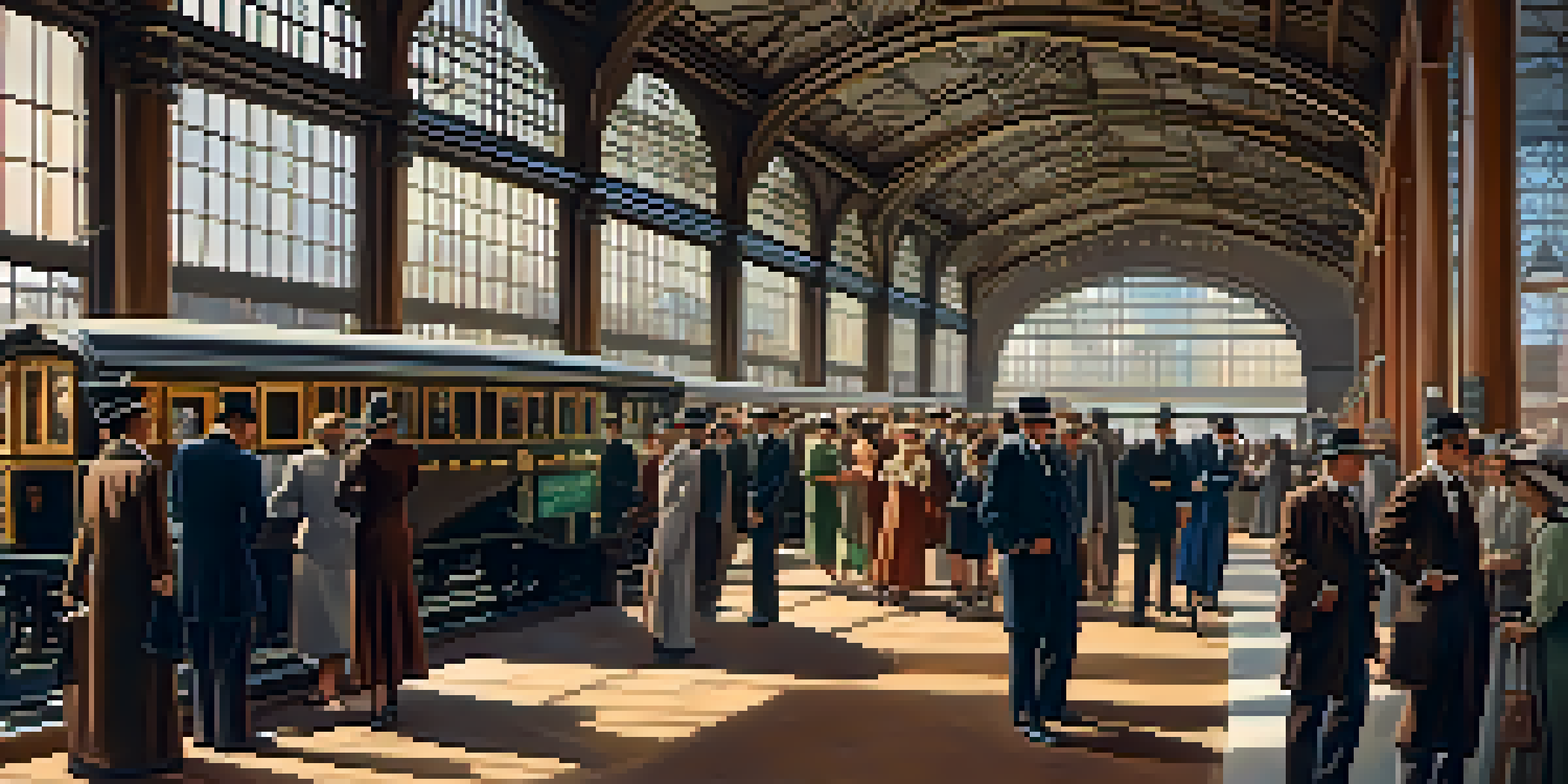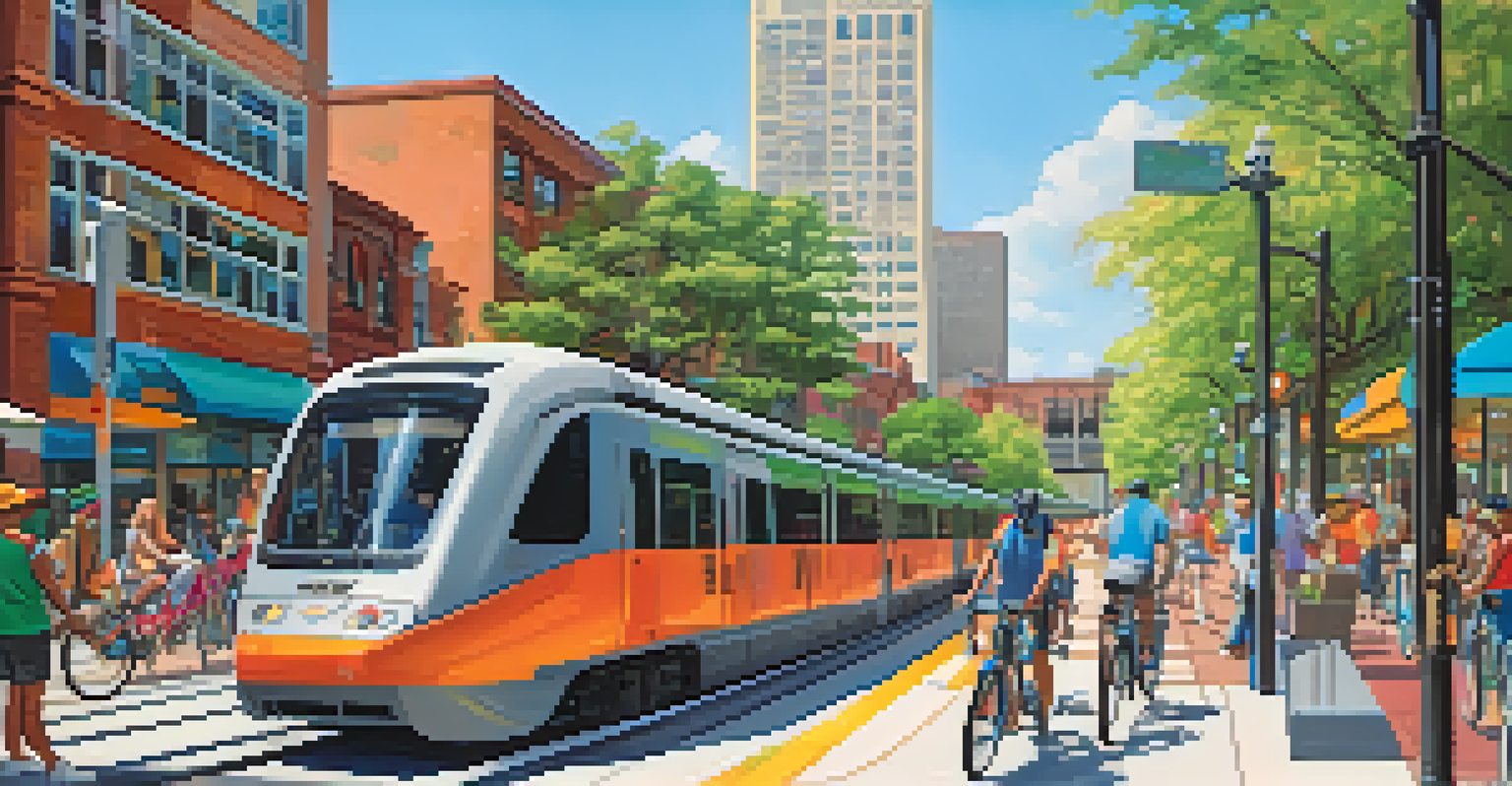The Role of Railroads in Jacksonville's Urban Development

The Birth of Railroads in Jacksonville
Railroads first made their mark in Jacksonville during the mid-19th century, fundamentally changing transportation in the region. Before the railroads, travel and trade relied heavily on waterways and dirt roads, which were often unreliable. The arrival of the Atlantic Coast Line Railroad in 1886 opened up new avenues for commerce, enabling goods to move swiftly in and out of the city. This shift not only boosted the local economy but also attracted new residents eager to take advantage of the growing job opportunities.
The railroad is a great equalizer. It brings the country closer together, provides access to the unknown, and creates a sense of unity among people from different backgrounds.
The establishment of rail lines connected Jacksonville to major markets across the Southeast, making it a strategic hub for trade. This connectivity encouraged businesses to set up shop in the city, leading to an economic boom. As the railroads expanded, they laid the groundwork for what would become a bustling urban center, filled with diverse industries and a growing population. This initial spark was crucial in shaping Jacksonville's future development.
The expansion of railroads also led to the development of neighborhoods and infrastructure around train stations. Areas like Riverside and San Marco began to flourish as people sought to live close to their places of work. These neighborhoods, filled with charming architecture and vibrant communities, reflect the lasting influence of railroads on Jacksonville's urban landscape.
Railroads and Economic Growth
The economic impact of railroads on Jacksonville was profound, paving the way for various industries to thrive. With the ability to transport goods quickly, businesses found it easier to reach customers beyond local markets. This newfound efficiency attracted manufacturers, wholesalers, and retailers, all eager to capitalize on the city's strategic position. As a result, Jacksonville became a bustling economic center, drawing in investments and stimulating job creation.

Railroads also played a vital role in the timber and citrus industries, which were significant to Florida's economy. The ease of transporting lumber and citrus products via rail allowed Jacksonville to become a key player in these markets. Local businesses grew exponentially, contributing to the city’s wealth and attracting even more residents seeking employment. This cycle of growth fostered a sense of community and economic stability that continues to benefit the city today.
Railroads Sparked Jacksonville's Growth
The arrival of railroads transformed Jacksonville into a strategic trade hub, boosting the local economy and attracting new residents.
Moreover, the railroads’ influence extended beyond just transportation; they brought cultural exchanges and new ideas to Jacksonville. As goods and people flowed in and out, the city became a melting pot of cultures, enriching its social fabric. This interplay between economic growth and cultural diversification showcases how railroads contributed not just to the economy, but to the identity of Jacksonville itself.
Transforming Transportation in Jacksonville
Before railroads, transportation in Jacksonville was limited and often cumbersome. The advent of rail travel drastically changed how residents and goods moved through the city. Commuters could now travel efficiently between neighborhoods, and businesses could receive supplies more quickly than ever. This transformation laid a foundation for the modern transportation systems we rely on today.
Railroads are a vital part of our country’s infrastructure and history, shaping not only our economy but also our culture and communities.
As railroads facilitated easier access to the city, they also encouraged the development of other transportation modes. Streetcars and buses emerged, connecting residents to different areas and expanding the urban landscape. This interconnectedness paved the way for the modern urban planning that we see in Jacksonville today, with neighborhoods designed to be accessible and pedestrian-friendly.
Railroads also sparked the creation of transport hubs, such as Jacksonville’s Union Station, which became a focal point for travel. These hubs not only served functional purposes but also became landmarks that reflected the city’s growth and ambition. The evolution of transportation in Jacksonville is a testament to how railroads have fundamentally shaped the city's infrastructure.
Urban Planning and Railroads
The influence of railroads on urban planning in Jacksonville cannot be overstated. As the city expanded around rail lines, planners had to consider how to integrate this new mode of transport into the urban environment. This led to the development of zoning laws and infrastructure that prioritized accessibility, ensuring that neighborhoods were connected to the rail system. Such planning was essential for fostering a cohesive urban landscape.
Railroads also prompted the design of public spaces that catered to the needs of commuters. Parks and plazas were created near train stations, providing areas for relaxation and community gatherings. These spaces not only enhanced the aesthetic appeal of the city but also encouraged social interaction among residents. This blend of functionality and design has made Jacksonville a more livable city.
Cultural Melting Pot from Railroads
Railroads facilitated diverse cultural exchanges, enriching Jacksonville's community life and fostering a vibrant arts scene.
Furthermore, the long-term vision of urban planners has ensured that Jacksonville remains adaptable to future transportation needs. The legacy of railroads continues to influence contemporary planning efforts, as the city looks to balance growth with sustainability. This foresight is crucial in maintaining the city’s vibrant character while accommodating an ever-evolving population.
Cultural Shifts Influenced by Railroads
The arrival of railroads not only impacted Jacksonville's economy but also its culture. As the city became more accessible, it attracted a diverse array of people, each contributing their own customs and traditions. This cultural melting pot enriched Jacksonville's community life, leading to vibrant festivals, art scenes, and culinary experiences that reflect the city's diverse heritage. The railroads helped shape a cultural identity that celebrated both local and international influences.
Moreover, railroads facilitated the spread of ideas and innovations, fostering a spirit of creativity and collaboration. Artists, musicians, and writers from different backgrounds converged in Jacksonville, inspired by the city’s dynamic atmosphere. This creative exchange resulted in a flourishing arts scene, as local talents found their voices and shared their stories with a broader audience. The cultural legacy of railroads is evident in the city's ongoing commitment to the arts.
The continued influence of railroads can also be seen in Jacksonville's historic neighborhoods, which tell the story of the city's past. Many buildings and landmarks from the railroad era remain, serving as reminders of the transformative power railroads had on urban life. These sites not only preserve history but also encourage residents and visitors to appreciate the rich tapestry of Jacksonville’s cultural landscape.
Challenges Faced by Railroads Over Time
Despite their significant contributions, railroads in Jacksonville have faced numerous challenges over the years. The rise of automobiles in the 20th century shifted transportation priorities, leading to a decline in rail usage. With highways becoming the preferred method of travel, railroads struggled to compete for both passengers and freight. This shift had profound implications for the city, as it redefined transportation dynamics and urban planning.
Additionally, changing economic conditions and competition from other transport modes resulted in the abandonment of certain rail lines. Many areas that once thrived due to rail access saw decline as businesses relocated or closed. This created gaps in the urban fabric, highlighting the importance of adaptive planning to address the evolving needs of the city. Jacksonville had to navigate these challenges to maintain its growth and relevance.
Future Focus on Sustainable Rail Transport
Jacksonville is exploring modern transportation innovations to revitalize its rail systems, enhancing connectivity and promoting eco-friendly travel.
Today, there is a renewed interest in revitalizing rail transport as cities seek sustainable solutions to transportation issues. Jacksonville is exploring ways to integrate rail systems with modern transit options, promoting public transport as a viable alternative. This shift not only honors the city's historical relationship with railroads but also paves the way for a more sustainable urban future.
The Future of Railroads in Jacksonville
Looking ahead, the future of railroads in Jacksonville appears promising as the city embraces modern transportation innovations. There is a growing recognition of the importance of rail systems in reducing traffic congestion and promoting eco-friendly travel. Initiatives are being developed to enhance existing rail services and explore new routes that connect underserved areas of the city. This focus on rail transport aligns with broader urban planning goals aimed at sustainability and connectivity.
Moreover, the community is becoming increasingly engaged in discussions about transportation options, advocating for public transit that meets diverse needs. This grassroots involvement is crucial for shaping a future where railroads remain a vital part of Jacksonville's identity. By harnessing public input and collaborating with stakeholders, the city can ensure that railroads continue to serve as a backbone for urban development.

Ultimately, the enduring legacy of railroads in Jacksonville is one of resilience and adaptation. As the city evolves, railroads will likely play a crucial role in shaping its urban landscape, fostering economic growth, and enriching the cultural experience. With a thoughtful approach to development, Jacksonville can honor its railroad heritage while embracing the opportunities of the future.